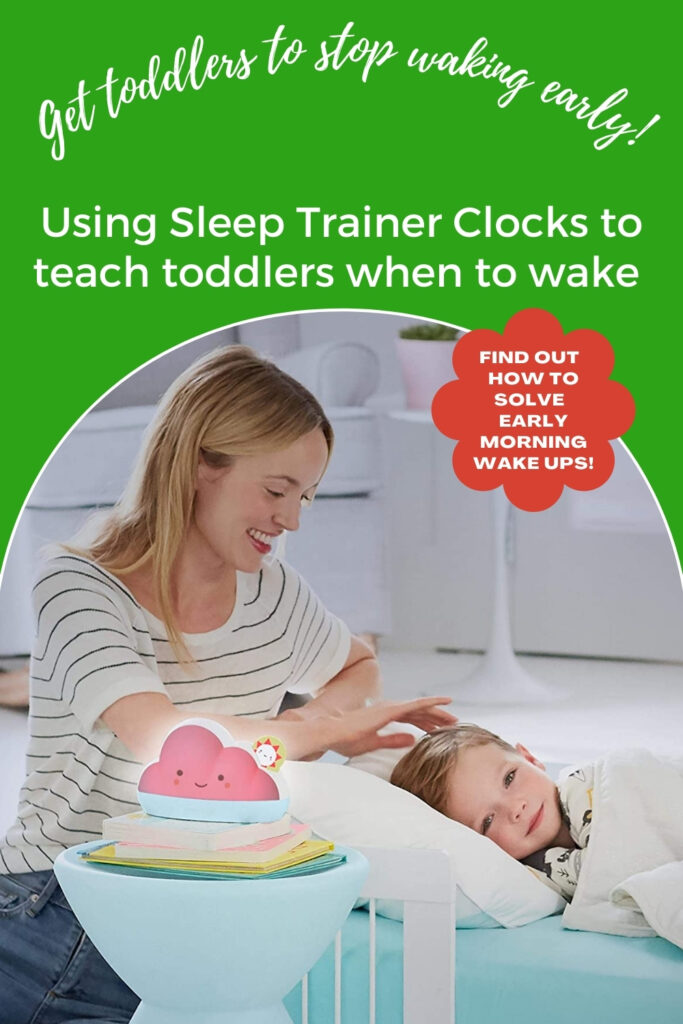In the summer in particular, because of the early morning light shining through our bedroom windows, it can be really hard for toddlers to understand when it is time to get out of bed in the morning. Their sleep cues are disrupted because it is getting lighter earlier in the day, and they don’t know to “stay put” because they cannot read the clocks in their bedrooms just yet. Have you tried sleep trainer clocks to help toddlers to understand the time more easily? If not, we’ve got some advice for you on how to use them so that they are likely to work for your family.

As with everything for little ones, try to be patient with them when you first bring a training clock into their bedroom. Stick with these principles though, and you won’t go far wrong.
How to use sleep trainer clocks so they actually work
We had a bunny alarm clock that we used for our children as they were growing up – the ears popped up when it was OK to get out of bed. Introduced because 5am wake ups are *not cool*, we quickly realised just how effective sleep trainer clocks could be if used with a few additional tools for toddlers:

1. Get your child to help buy the clock
As with anything, you NEED to get your toddler’s buy in with anything that you are trying to introduce to them. Get them to help choose the sleep trainer clock you are going to have. There are loads of them on the market; we recommend the Skip Hop Sleep Trainer because it also doubles up as a nightlight, as well as playing a gentle lullaby for soothing too.
2. Choose something visual and appealing
In order for your toddler to understand what is expected of them for their sleep trainer clock, it needs to be simple. Something that helps them understand when it is time to get up, either with a visual or a colour cue is the most effective. Our kids had bunny ears, Skip Hop uses colours to help children understand when it is OK to get out of bed; green for “get up” and red for “time for bed.”
Simple, but effective, and easy for little ones to understand from an early age too.
3. Reinforce the idea of staying in bed with a reward system
After explaining how the new clock works, when you have it in their room, and they are using it – reinforce the behaviours that you are trying to work towards with gentle rewards. Perhaps you can use our reward charts to support the clock?
When you are explaining the sleep training clocks; keep it simple, and easy to understand, so your toddlers know that, in the case of the Skip Hop, red means it is time to stay in bed, and green means they can get up and come see you in your room.
Do make sure you are thinking about what time they are going to bed vs how old they are too. We do have a sleep guide on the site, so check this out too. It is important to understand how much sleep your little ones need; these are guides of course though, and everybody’s child is different. You know your little ones best. If they are waking early, and there is nothing that you can do about it, consider adjusting their bedtime a little bit too, alongside the use of the clock.

4. Praise, praise and more praise
If they get it right, praise, praise, and praise them some more! Of course, we need to be gentle if they misunderstand, or don’t quite manage it at first; it’s all a learning curve for them and you.
5. Stick with it and be patient
Sometimes your toddler might falter with their sleep trainer clock – don’t give up, stick with it, and be patient. It does take them a little time to understand the mechanism for realising when it is OK to get out of bed. They’ll get there, and hopefully that’ll put an end to the 5am wake up calls!
Good luck with getting your toddlers to stay in bed, we really hope that these tips work for you.
If you like this article – do sign up to our weekly newsletter.
We do have other sleep related articles on the site, so check some of these out as well.
There are also great sleep resources elsewhere too.
Do come back to the site again soon, we love having you here.
Helen




